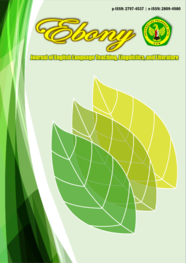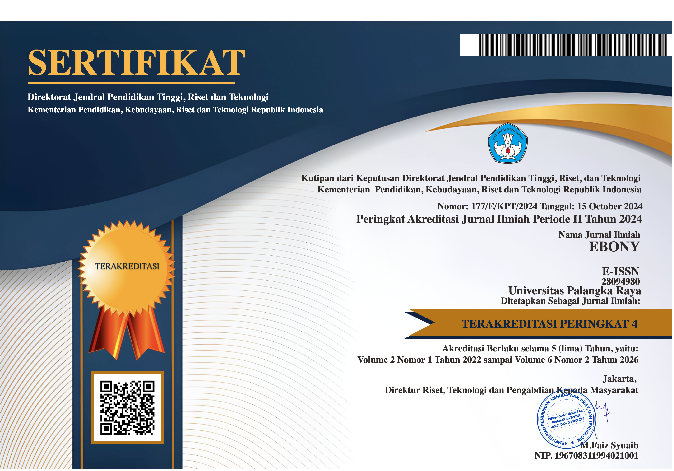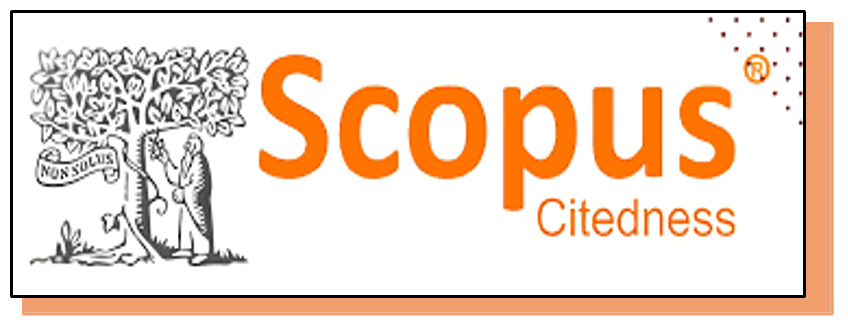Revolution in Fable Universe: Introducing Technology in Children's Literature
DOI:
https://doi.org/10.37304/ebony.v5i2.20217Keywords:
fable, technology, children’s literature, digital literacyAbstract
This research explores the integration of technology into fable narratives as a means of introducing digital literacy to children, thus, it aims at investigating the perspectives of three experienced literature lecturers on how technology can be embedded within fable stories, focusing on narrative structure and moral conflicts. Employing a qualitative research design with a narrative approach, data were collected through in-depth interviews with literature. Thematic analysis was used to interpret the findings. Results reveal a shared view that technology should not merely serve as a narrative backdrop but should catalyse critical reflections on ethical, social, and personal dimensions of digital life. Fables are seen as an adaptable medium to instil both traditional values and modern critical thinking about technology. The study concludes that technologically infused fables have the potential to enrich children’s literature, balancing aesthetic integrity with the demands of digital literacy. It is suggested that future research expands into creating and testing specific fable models within educational settings.
Keywords: Fable, Technology, Children’s Literature, Digital Literacy
Downloads
References
Abrar, M. (2016). Learning from Fables: Moral Values in Three Selected English Stories. Dinamika Ilmu. https://doi.org/10.21093/di.v16i1.250
Afandi, I., & Juanda, J. (2020). Application of Character Education Values in Early Childhood Through Online Fables. Aksis : Jurnal Pendidikan Bahasa Dan Sastra Indonesia, 4(1). https://doi.org/10.21009/aksis.040108
Afriyanti, M., Agustina, E., & Canrhas, A. (2018). Nilai-nilai pendidikan karakter cerita rakyat nasal sebagai bahan ajar bahasa Indonesia SMP kelas VII. Jurnal Ilmiah KORPUS, 2(1). https://doi.org/10.33369/jik.v2i1.5557
Axell, C. (2017). Technology and Children’s Literature. In Encyclopedia of Earth Sciences Series. https://doi.org/10.1007/978-3-319-38889-2_66-1
Brey, P. (2018). The strategic role of technology in a good society. Technology in Society, 52. https://doi.org/10.1016/j.techsoc.2017.02.002
Candra Dewi, R. (2011). Pengembangan komik fabel sebagai suplemen pendidikan lingkungan dalam rangka kampanye pelestarian flora dan fauna bagi siswa kelas 1 MI Al – Abror Magetan tahun 2016/2017. MUADDIB: Studi Kependidikan Dan Keislaman, 7(1). https://doi.org/10.24269/muaddib.v7n1.2017.67-71
Carson, V., Tremblay, M. S., Spence, J. C., Timmons, B. W., & Janssen, I. (2013). The Canadian Sedentary Behaviour Guidelines for the Early Years (zero to four years of age) and screen time among children from Kingston, Ontario. Paediatrics and Child Health (Canada), 18(1). https://doi.org/10.1093/pch/18.1.25
Danaher, J., & Sætra, H. S. (2022). Technology and moral change: the transformation of truth and trust. Ethics and Information Technology, 24(3). https://doi.org/10.1007/s10676-022-09661-y
Donohue, C. (2019). Introduction: Powerful ideas about young children and technology: Thoughts from the thought leaders. In Exploring Key Issues in Early Childhood and Technology: Evolving Perspectives and Innovative Approaches. https://doi.org/10.4324/9780429457425-1
Dwi Apriliani, D., Nurdianasari, N., Darmayanti, V., Badrus Sholeh Arif, M., & Cahyanto, B. (2023). Nilai-nilai pendidikan karakter dalam dongeng Domba dan Sahabat Rimba karya Kak Thifa sebagai alternatif bahan ajar peserta didik kelas II Sekolah Dasar. EduStream: Jurnal Pendidikan Dasar, 7(2). https://doi.org/10.26740/eds.v7n2.p110-119
Eteokleous, N., Ktoridou, D., & Demetris, D. (2008). Aesop’s Fables: A technology-based delivery. International Journal of Technology Enhanced Learning, 1(1–2). https://doi.org/10.1504/IJTEL.2008.020234
Fleer, M. (1992). Introducing technology education to young children: A design, make and appraise approach. Research in Science Education, 22(1). https://doi.org/10.1007/BF02356888
Goldfarb, G., & Krynski, L. (2016). Exposure and use of mobile media devices by young children. In Archivos Argentinos de Pediatria (Vol. 114, Issue 2). https://doi.org/10.1542/peds.2015-2151d
Hou, X., Omar, N., & Wang, J. (2022). Interactive Design Psychology and Artificial Intelligence-Based Innovative Exploration of Anglo-American Traumatic Narrative Literature. Frontiers in Psychology, 12. https://doi.org/10.3389/fpsyg.2021.755039
Huda, M. (2019). Empowering application strategy in the technology adoption. Journal of Science and Technology Policy Management, 10(1). https://doi.org/10.1108/jstpm-09-2017-0044
Iyanda, R. O. (2020). Fables as Panacea to Unethical Behaviours in Societies. SSRN Electronic Journal. https://doi.org/10.2139/ssrn.3607957
Jaja, J., Kusmana, S., Asman, N., Hardjowikarto, D., & Amaliyah, L. (2020). Technology Use in Fabel Text Teaching Materials and its Use in Secondary Schools. International Journal of Innovation, Creativity and Change, 13(3).
Jurahman, Y. D. (2022). Implementasi Mendongeng pada Mata Pelajaran Bahasa Indonesia untuk Penanaman Karakter Anak Sekolah Dasar. Scholaria: Jurnal Pendidikan Dan Kebudayaan, 12(2). https://doi.org/10.24246/j.js.2022.v12.i2.p161-167
Kabali, H. K., Irigoyen, M. M., Nunez-Davis, R., Budacki, J. G., Mohanty, S. H., Leister, K. P., & Bonner, R. L. (2015). Exposure and use of mobile media devices by young children. Pediatrics, 136(6). https://doi.org/10.1542/peds.2015-2151
Khilmi, M., Sulistiani, I. R., & Dewi, M. S. (2020). Analisis nilai karakter yang terkandung pada cerita anak berjenis fabel pada buku siswa kelas 2 tema 7 SD/MI. JPMI: Jurnal Pendidikan Madrasah Ibtidaiyah, 2(3). https://jim.unisma.ac.id/index.php/JPMI/article/view/7609/6116
Klenk, M. (2021). How Do Technological Artefacts Embody Moral Values? Philosophy and Technology, 34(3). https://doi.org/10.1007/s13347-020-00401-y
Kusmana, S., Mulyaningsih, I., Suryaman, M., & Septiaji, A. (2021). Pengembangan bahan ajar teks fabel bermuatan kearifan lokal untuk pembelajaran bahasa indonesia. Sawerigading, 27(1). https://doi.org/10.26499/sawer.v27i1.894
Liu, Y. (2022). The Silence of Digital Practices in Contemporary Fiction Picture Books. Alberta Academic Review, 5(1). https://doi.org/10.29173/aar137
Manshur, F. M. (2023). The Function of Fables for Early Children’s Character Education. Journal of Media & Management. https://doi.org/10.47363/jmm/2023(5)157
Meng, Q., Yan, Z., Abbas, J., Shankar, A., & Subramanian, M. (2023). Human-Computer Interaction and Digital Literacy Promote Educational Learning in Pre-school Children: Mediating Role of Psychological Resilience for Kids’ Mental Well-Being and School Readiness. International Journal of Human-Computer Interaction. https://doi.org/10.1080/10447318.2023.2248432
Mytton, O. T., Velazquez, A., Banken, R., Mathew, J. L., Ikonen, T. S., Taylor, K., Painter, F., Jean-Baptiste, R., Poon, A., & Ruelas, E. (2010). Introducing new technology safely. Quality & Safety in Health Care, 19 Suppl 2. https://doi.org/10.1136/qshc.2009.038554
Nippold, M. A., & Marr, E. (2022). Philosophy for Adolescents: Using Fables to Support Critical Thinking and Advanced Language Skills. Language, Speech, and Hearing Services in Schools, 53(3). https://doi.org/10.1044/2022_LSHSS-21-00142
Niu, J. (2021). Improve the Appreciation of Literary Works of College Students Based on Virtual Reality Technology Simulation. Proceedings - 2021 International Symposium on Advances in Informatics, Electronics and Education, ISAIEE 2021. https://doi.org/10.1109/ISAIEE55071.2021.00090
Pan, Z., López, M. F., Li, C., & Liu, M. (2021). Introducing augmented reality in early childhood literacy learning. Research in Learning Technology, 29. https://doi.org/10.25304/rlt.v29.2539
Panjaitan, H., Nirmalasari, S., & Damayanti, A. (2023). The role of parents in the introduction of digital literacy in early children. Proceeding International Seminar on Islamic Studies, 4. https://doi.org/10.3059/insis.v0i0.14152.g8845
Papadakis, S. (2021). The Impact of Coding Apps to Support Young Children in Computational Thinking and Computational Fluency. A Literature Review. In Frontiers in Education (Vol. 6). https://doi.org/10.3389/feduc.2021.657895
Stables, K. (1997). Critical Issues to Consider When Introducing Technology Education into the Curriculum of Young Learners. Journal of Technology Education, 8(2). https://doi.org/10.21061/jte.v8i2.a.4
Sukirman. (2021). Karya Sastra Media Pendidikan Karakter bagi Peserta Didik. Jurnal Konsepsi, 10(1). https://p3i.my.id/index.php/konsepsi/article/view/4/5
Sultan, A., & Ammari, D. (2022). Children and Adolescents’ Voices and Experiences in Climate Fiction. World Journal of English Language, 12(8). https://doi.org/10.5430/wjel.v12n8p420
Suryaman, M. (2010). Pendidikan karakter melalui pembelajaran sastra. Jurnal Cakrawala Pendidikan, 1(3). https://doi.org/10.21831/cp.v1i3.240
Świerczyńska-Kaczor, U. (2024). Empirical insights into traditional and AI-enhanced interactive narratives based on children’s fables. Journal of Economics and Management (Poland), 46(1). https://doi.org/10.22367/jem.2024.46.02
Tasić-Ranđelović, S. (2023). Fable, drama structure and its application in teaching. Obrazovanje i Vaspitanje, 18(20). https://doi.org/10.5937/obrvas18-47730
Wati, N., & Gularso, D. (2022). Analysis of the value of character education in the fable of the Mouse Deer and His Best Friend. Elementary School: Jurnal Pendidikan Dan Pembelajaran Ke-SD-An, 9(2). https://doi.org/10.31316/esjurnal.v9i2.2126
Wissang, I. O., Pande, R., & Deta, B. (2023). Pendampingan Menulis Cerita Fabel Berbasis Kearifan Budaya Lamaholot di SMPS Ratu Damai, Flores Timur. Amalee: Indonesian Journal of Community Research and Engagement, 4(2). https://doi.org/10.37680/amalee.v4i2.2771
Wood, E., Petkovski, M., De Pasquale, D., Gottardo, A., Evans, M. A., & Savage, R. S. (2016). Parent scaffolding of young children when engaged with mobile technology. Frontiers in Psychology, 7(MAY). https://doi.org/10.3389/fpsyg.2016.00690
Yektiningtyas, W., & Silalahi, E. (2020). Fables as Media of Environmental Education for Sentani Children in Jayapura Regency, Papua. Celt: A Journal of Culture, English Language Teaching & Literature, 20(2). https://doi.org/10.24167/celt.v20i2.2867
Downloads
Published
How to Cite
Issue
Section
License
Copyright (c) 2025 Ferra Dian Andanty, Rahmat Setiawan; Titah Kinasih, Meytha Dwi Kurnia, Dolmat Doyat

This work is licensed under a Creative Commons Attribution 4.0 International License.











